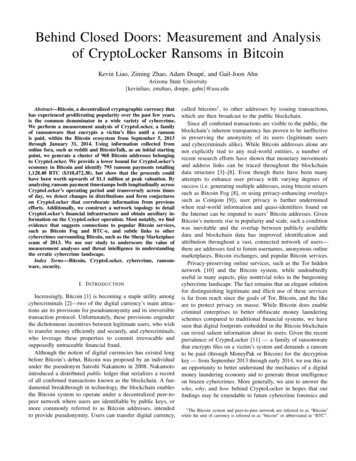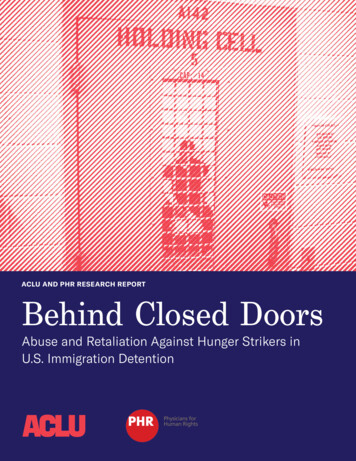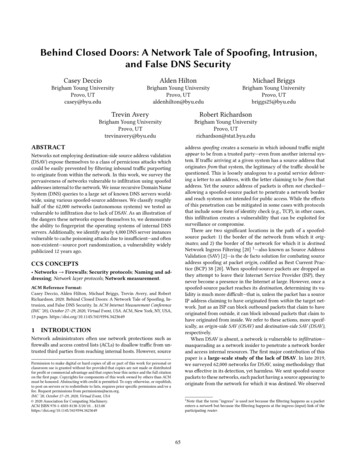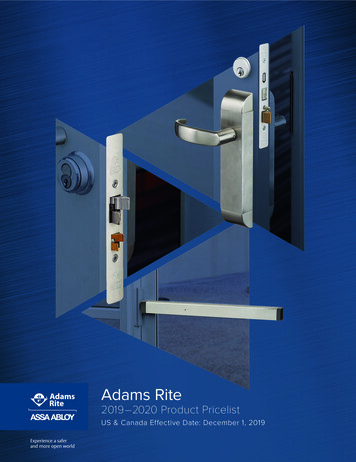
Transcription
Behind Closed Doors: Measurement and Analysisof CryptoLocker Ransoms in BitcoinKevin Liao, Ziming Zhao, Adam Doupé, and Gail-Joon AhnArizona State University{kevinliao, zmzhao, doupe, gahn}@asu.educalled bitcoins1 , to other addresses by issuing transactions,which are then broadcast to the public blockchain.Since all confirmed transactions are visible to the public, theblockchain’s inherent transparency has proven to be ineffectivein preserving the anonymity of its users (legitimate usersand cybercriminals alike). While Bitcoin addresses alone arenot explicitly tied to any real-world entities, a number ofrecent research efforts have shown that monetary movementsand address links can be traced throughout the blockchaindata structure [3]–[8]. Even though there have been manyattempts to enhance user privacy with varying degrees ofsuccess (i.e. generating multiple addresses, using bitcoin mixerssuch as Bitcoin Fog [8], or using privacy-enhancing overlayssuch as Coinjoin [9]), user privacy is further underminedwhen real-world information and quasi-identifiers found onthe Internet can be imputed to users’ Bitcoin addresses. GivenBitcoin’s meteoric rise in popularity and scale, such a conditionwas inevitable and the overlap between publicly availabledata and blockchain data has improved identification andattribution throughout a vast, connected network of users—there are addresses tied to forum usernames, anonymous onlinemarketplaces, Bitcoin exchanges, and popular Bitcoin services.Privacy-preserving online services, such as the Tor hiddennetwork [10] and the Bitcoin system, while undoubtedlyuseful in many aspects, play nontrivial roles in the burgeoningI. I NTRODUCTIONcybercrime landscape. The fact remains that an elegant solutionfor distinguishing legitimate and illicit use of these servicesIncreasingly, Bitcoin [1] is becoming a staple utility among is far from reach since the goals of Tor, Bitcoin, and the likecybercriminals [2]—two of the digital currency’s main attrac- are to protect privacy en masse. While Bitcoin does enabletions are its provisions for pseudoanonymity and its irreversible criminal enterprises to better obfuscate money launderingtransaction protocol. Unfortunately, these provisions engender schemes compared to traditional financial systems, we havethe dichotomous incentives between legitimate users, who wish seen that digital footprints embedded in the Bitcoin blockchainto transfer money efficiently and securely, and cybercriminals, can reveal salient information about its users. Given the recentwho leverage these properties to commit irrevocable and prevalence of CryptoLocker [11] — a family of ransomwaresupposedly untraceable financial fraud.that encrypts files on a victim’s system and demands a ransomAlthough the notion of digital currencies has existed long to be paid (through MoneyPak or Bitcoin) for the decryptionbefore Bitcoin’s debut, Bitcoin was proposed by an individual key — from September 2013 through early 2014, we use this asunder the pseudonym Satoshi Nakamoto in 2008. Nakamoto an opportunity to better understand the mechanics of a digitalintroduced a distributed public ledger that serializes a record money laundering economy and to generate threat intelligenceof all confirmed transactions known as the blockchain. A fun- on brazen cybercrimes. More generally, we aim to answer thedamental breakthrough in technology, the blockchain enables who, why, and how behind CryptoLocker in hopes that ourthe Bitcoin system to operate under a decentralized peer-to- findings may be extendable to future cybercrime forensics andpeer network where users are identifiable by public keys, ormore commonly referred to as Bitcoin addresses, intended1 The Bitcoin system and peer-to-peer network are referred to as “Bitcoin”to provide pseudonymity. Users can transfer digital currency, while the unit of currency is referred to as “bitcoin” or abbreviated as “BTC”.Abstract—Bitcoin, a decentralized cryptographic currency thathas experienced proliferating popularity over the past few years,is the common denominator in a wide variety of cybercrime.We perform a measurement analysis of CryptoLocker, a familyof ransomware that encrypts a victim’s files until a ransomis paid, within the Bitcoin ecosystem from September 5, 2013through January 31, 2014. Using information collected fromonline fora, such as reddit and BitcoinTalk, as an initial startingpoint, we generate a cluster of 968 Bitcoin addresses belongingto CryptoLocker. We provide a lower bound for CryptoLocker’seconomy in Bitcoin and identify 795 ransom payments totalling1,128.40 BTC ( 310,472.38), but show that the proceeds couldhave been worth upwards of 1.1 million at peak valuation. Byanalyzing ransom payment timestamps both longitudinally acrossCryptoLocker’s operating period and transversely across timesof day, we detect changes in distributions and form conjectureson CryptoLocker that corroborate information from previousefforts. Additionally, we construct a network topology to detailCryptoLocker’s financial infrastructure and obtain auxiliary information on the CryptoLocker operation. Most notably, we findevidence that suggests connections to popular Bitcoin services,such as Bitcoin Fog and BTC-e, and subtle links to othercybercrimes surrounding Bitcoin, such as the Sheep Marketplacescam of 2013. We use our study to underscore the value ofmeasurement analyses and threat intelligence in understandingthe erratic cybercrime landscape.Index Terms—Bitcoin, CryptoLocker, cybercrime, ransomware, security.
analytics. Our contributions are the following: We design and implement a framework that collects datafrom the blockchain and automatically identifies ransompayments to Bitcoin addresses belonging to CryptoLocker.From this, we measure CryptoLocker’s economy in Bitcoinand provide a lower-bound estimate of financial damagesfrom September 5, 2013 through January 31, 2014. We present a novel approach to analyzing Bitcoin transactions by examining ransom payment timestamps bothlongitudinally across CryptoLocker’s operating period, aswell as tranversely across times of day, to distinguishtrends and changes in timestamp distributions. We construct a non-trivial, topological network of CryptoLocker addresses and systematically examine CryptoLocker’s financial infrastructure and money launderingstrategies. By leveraging external, real-world data, wefind connections to popular services such as Bitcoin Fogand BTC-e, and speculate connections to other Bitcoincybercrime, such as the Sheep Marketplace heist.II. BACKGROUNDTo understand our analysis of the CryptoLocker economy,we first discuss the Bitcoin protocol in Section II-A, and wenext discuss the CryptoLocker ransomware in Section II-B.A. Anatomy of a Bitcoin TransactionBitcoin is a decentralized cryptographic currency that wasproposed by Satoshi Nakamoto in 2008 [1]. A bitcoin canbe abstracted as a chain of transactions among owners whoare identifiable by public keys generated from an asymmetricencryption scheme2 . We will refer to these public keys asBitcoin addresses, or simply addresses, throughout the rest ofthis paper.To transfer bitcoins, a user issues a transaction, whichconsists of a set of inputs, a set of outputs, and a changeaddress. The inputs are Bitcoin addresses that belong to thepayer. The outputs are Bitcoin addresses that identify the payeeaccounts, and the change address (which is optional) is wherethe leftover bitcoins from the transactions are sent (the changeaddress belongs to the payer). Bitcoin’s transaction protocolstipulates that inputs to a new transaction must reference theexact value of outputs from previous transactions. In otherwords, users must specify from whom they received the bitcoins,thus forming a chain of transactions, and inputs to a newtransaction may reference as many previous transactions neededto sufficiently fund the new output. These are known as multiinput transactions. Finally, the payer digitally signs a hash3 ofthe transaction from which he or she received the bitcoins andthe public key address of the payee.We illustrate Bitcoin’s transaction protocol in Figure 1. Wesee that there are three transactions, A, B, and C, and we willrefer to their respective owners as Alice, Bob, and Charlie. Intransaction A, a transaction of 2.0 BTC sent to Alice is used as2 EllipticCurve Digital Signature Algorithm (ECDSA)3 SHA-256Fig. 1. The diagram illustrates the anatomy of bitcoin transactions. We havetransactions A, B, and C owned by Alice, Bob, and Charlie, respectively. Wecan see that previous transactions to Alice and Bob are referenced in theirrespective transactions to Charlie, forming a chain of transactions.an input to a transaction of 1.5 BTC to Charlie. Since the inputvalue exceeds the output value, the remaining 0.5 BTC is sent toa change address belonging to Alice. In transaction B, we see asimilar scenario in which Bob transfers 1.0 BTC to Charlie, buta change address is not necessary because the input and outputvalues were equivalent. In transaction C, we see that Charlietransfers 2.0 BTC to an unnamed user. To issue this transaction,transaction C references the two previous transactions, fromAlice and Bob, that Charlie received as inputs. Again, the totalinput value exceeds the required output value, so 0.5 BTC aresent to a change address belonging to Charlie.We can see that the validity of a bitcoin is dependent onthe correctness of each signature in the transaction chain, it issimple to verify a transaction’s history but difficult to tamperwith confirmed transactions that are deeply embedded in theblockchain (usually six blocks of confirmation is consideredsecure against double-spending attacks [12]). Therefore, Bitcointransactions are essentially irreversible. This feature, coupledwith Bitcoin’s pseudonymity, enables cybercriminals to commitfinancial fraud that is virtually impossible to reverse anddifficult to trace.B. CryptoLocker RansomwareOn September 5, 2013, CryptoLocker emerged as a newfamily of ransomware that encrypted files on a victim’s systemuntil a ransom is paid [11]. The decryption keys were withheldby the threat actors who demanded ransoms to be paid eitherthrough MoneyPak or Bitcoin within 72 hours, otherwise thedecryption keys would (allegedly) be destroyed and recoveryof the encrypted files would be virtually impossible.CryptoLocker’s infection vector took two forms. In its initialrelease, CryptoLocker threat actors primarily targeted businessprofessionals via spam emails taking the form of “customercomplaints” against recipients’ organizations. Malicious executable files were attached in ZIP archives, which wouldaggressively encrypt all the files on a system if opened. Laterversions of CryptoLocker, beginning on October 7, 2013, weredistributed through Gameover ZeuS [13], a peer-to-peer botnetthat used Cutwail spam botnet to send massive amounts ofspam email impersonating well-established online retailers and
III. M EASUREMENT M ETHODOLOGYWe next explain our approach to collecting informationfrom the blockchain and various online fora in an effortto measure CryptoLocker’s economy and generate threatintelligence on the CryptoLocker operation. We begin byhighlighting how we generated an address cluster belonging toCryptoLocker, which we call SCL , from two seed addresses inSection III-A. Based on information from previous efforts and apreliminary examination of SCL , we designed and implementeda framework for identifying ransom payments from the set ofall transactions sent to our cluster in Section III-B.900USD per BTCfinancial institutions. These emails typically spoofed invoices,order confirmations, or urgent unpaid balances to lure victimsinto following malicious links which redirected to CryptoLockerexploit kits.From September 2013 through early 2014, CryptoLockerinfections were most prevalent in the United States. A studyfrom the Dell SecureWorks Counter Threat Unit (CTU) researchteam [11] shows that from October 22, 2013 to November1, 2013, 22,360 systems were infected in the United States,constituting 70.2% of global CryptoLocker infections. Duringthis period, CryptoLocker was also prevalent in Canada, GreatBritain, India, and several countries in the Middle East andSouth Central Asia. In a later sample, gathered from December9, 2013 to December 16, 2013, during a sinkhole when CryptoLocker activity was limited, CryptoLocker infections becamemore dispersed. The concentration of infected systems in theUnited States dramatically declined to 23.8% (1,540 infectedsystems) and CryptoLocker activity became more prevalent inGreat Britain (1,228 infected systems constituting 19.0% ofglobal infections), Australia (836 infections constituting 12.9%of global infections), several other European countries, China,India, and Brazil.Although the United States is disproportionately representedin total global CryptoLocker infections, most ransom paymentsfrom the United States were issued through MoneyPak, aninvariably more economical option than Bitcoin. This was dueto bitcoin’s price volatility at the time. Conversion rates soaredfrom 120/BTC in September 2013 to well over 1,300/BTC inlate November 2013. We show the exchange rate of US dollarsand bitcoin throughout CryptoLocker’s operational period inFigure 2. As a result, the CryptoLocker threat actors adjustedthe ransom demand on several occasions to ensure that ransomdemands were not exorbitant. Since, in almost all cases in theUnited States, there were no advantages to paying throughthe Bitcoin system, individuals who elected to pay via Bitcoinpresumably resided in countries outside of the United Stateswhere MoneyPak was unavailable [11]. For this reason, bitcoinransom payments represent only a small portion of the totalfinancial damages caused by CryptoLocker.600300Sep 2013Oct 2013Nov 2013Dec 2013DateJan 2014Feb 2014Fig. 2. The plot shows exchange rates between US dollars and bitcoins duringCryptoLocker’s operational period from September 2013 through January2014.for forensic analysis of the blockchain. Initially, we found twoknown CryptoLocker addresses by manually investigating areddit thread4 in which victims and researchers posted Bitcoinaddresses belonging to the ransomware. We will refer to oneof these seed addresses, which collected 27 ransom payments,as Aseed1 , and the other seed address, which collected 23ransom payments, as Aseed2 , throughout the remainder of thispaper. An interested reader can find the hashes of all Bitcoinaddresses mentioned in the Appendix. To expand our dataset ofaddresses, we use the following two clustering heuristics (basedon the Bitcoin transaction protocol detailed in Section II-A)to generate a set of Bitcoin addresses controlled by the sameuser(s), known as clusters [4]:1) Multi-input Transactions: A multi-input transaction occurs when a user u makes a transaction in whichthe payment amount p exceeds the available bitcoins(references of prior payments to u) in u’s wallet5 . Insuch a case, the Bitcoin protocol inputs a set of bitcoinsB from u’s wallet to sufficiently fund p. Therefore, wecan conclude that if the bitcoins in B are owned by aset of distinct input addresses Si , the input addresses inSi are controlled by the same user u.2) Change Addresses: The Bitcoin protocol generates a newchange address in u’s wallet to collect change when thesum of inputs in B exceeds p. When the set of outputaddresses So contains two addresses such that one is anewly generated address an and the other correspondsto a payment’s destination address ad , we can concludethat an is a change address and is controlled by u.From Aseed1 , we generate a set of 968 Bitcoin addressesbelonging to the CryptoLocker cluster, SCL , which happensto include Aseed2 . Although our study does not claim to berepresentative of the entire CryptoLocker population within theBitcoin ecosystem, which is difficult to quantify due to a lackA. Collecting and Generating AddressesTo collect Bitcoin addresses belonging to CryptoLocker,we used an approach similar to M. Spagnuolo’s study onCryptoLocker using BitIodine [7], an open source framework4 isturbing bitcoinvirus encrypts instead of/5 A “wallet” is a collection of private keys. It is the Bitcoin equivalent of abank account.
of confirmed Bitcoin addresses belonging to CryptoLocker,we can systematically measure a subset of CryptoLocker’seconomy, SCL , and make inferences about CryptoLocker andits constituents.B. Ransom Identification FrameworkIV. DATA OVERVIEWWe begin by validating the accuracy of our data and showinghow conservative our estimates are in Section IV-A. We thenperform valuations of the CryptoLocker economy and measureransom payments at different stages in its operational periodin Section IV-B.The goal of our ransom identification framework is to distinguish ransom payments from the set of all transactions to SCL . A. Data ValidationForemost, we designed and implemented our identificationWe realize that it is difficult to both comprehensivelyframework to be precise — we wanted to identify ransom measure SCL ’s economy and precisely identify all ransompayments with a high degree of confidence and minimize the payments to SCL beyond a reasonable doubt. In turn, thenumber of extraneous transactions included in our dataset. stringent transaction value and timestamp parameters used inSecond, we built our framework to be lightweight — rather our ransom identification framework provide a lower boundthan querying the entire Bitcoin blockchain, we chose a semi- estimate of ransom payments and SCL ’s economy. To gaugeautomatic approach to crawl and parse transactions to SCL how conservative our previous estimates are using the aforemenusing the Blockchain API [14]. For each address in SCL , points tioned framework, we take three different measurements withof interest included the total number of transactions, total sent varying transaction value and timestamp parameters. The threeand received bitcoins, and the number of ransom payments measurement methods are as follows: Method 1) transactions toreceived. For each transaction, we were interested in input SCL without any transaction value or timestamp filters, Methodand output addresses, bitcoins transferred, and timestamps (in 2) transactions to SCL filtered only by transaction values, andUNIX epoch time).Method 3) transactions to SCL filtered by both transactionThe time and ransom parameters in our identification frame- values and timestamps (ransom identification framework).work reflected findings from previous studies on CryptoLockerransomware [7], [11] and our own cursory analysis of SCL .TABLE IM EASUREMENTS BY M ETHODThe heuristics we use are as follows: Payments of approximately 2 BTC ( 0.1 BTC) betweenMethodTransactionsBTCUSDSeptember 5, 20136 (CryptoLocker release date) andMethod 11,0711,541.39539,080.69November 11, 2013 to allow for a three-day ransom periodMethod 29331,257.27373,934.76after CryptoLocker authors decreased the ransom amountMethod37951,128.40310,472.38to 1 BTC around November 8 Payments of approximately 1 BTC ( 0.1 BTC) betweenNovember 8, 2013 and November 13, 2013 to allow forTable I and Figure 3 show the daily volumes of bitcoinsa three-day ransom period after CryptoLocker authors de- paid to SCL , and their values in US dollars commensurate withcreased the ransom amount to 0.5 BTC around November daily exchange rates7 , using the three different measurements.10We see that there are clear disparities between our estimates Payments of approximately 0.5 BTC ( 0.05 BTC) be- from Method 1, which accounted for all transactions to SCL ,tween November 10, 2013 and November 27, 2013 to compared to our estimates from Method 2 or 3, particularly inallow for a three-day ransom period after CryptoLocker the month of November. The causes of the discrepancies onauthors decreased the ransom amount to 0.3 BTC around November 13 and 14 are four 7 BTC transactions, which areNovember 24filtered by Methods 2 and 3, that we cannot find any conclusive Payments of approximately 0.3 BTC ( 0.05 BTC) be- evidence on. The causes of the discrepancies from Novembertween November 24, 2013 and December 31, 201325 through November 27 are eight 4 BTC transactions and a Late payments of approximately 10 BTC ( 0.1 BTC)single transaction8 of 15.6 BTC (November 25). We discoverbetween November 1, 2013 and November 11, 2013 when that these transactions eventually end up in the secondaryCryptoLocker introduced their “CryptoLocker Decryption money laundering address used in the Sheep Marketplace scamService” for victims who failed to pay ransoms within of 2013 (see Section VI-B). Comparing estimates betweenthe given time frameMethod 2, which filtered transactions based on known ransom Late payments of approximately 2 BTC ( 0.1 BTC)amounts demanded by CryptoLocker (i.e. 2 BTC, 0.5 BTC, 0.3between November 11, 2013 and January 31, 2014 when BTC), and Method 3, which filtered transactions by ransomCryptoLocker decreased the cost of their “CryptoLocker amounts and their respective periods of activity, we see smallerDecryption Service”differences between our estimates, which is a good indication Payments of approximately 0.6 BTC ( 0.1 BTC) betweenthat the time intervals chosen in our ransom identificationDecember 20, 2013 and January 31, 20146 Timeintervals are in Universal Time Coordinates (UTC) from the start ofthe initial day to the end of the final day.7 There are many BTC/USD exchange rates available. We use the “24haverage” BTC/USD exchange rate from http://www.quandl.com.8 https://blockchain.info/tx/43355544/
80BTC6040200Sep 2013Oct 2013Nov 2013Dec 2013Jan 2014Feb 2014Dec 2013Jan 2014Feb 2014DateUSD (in thousands)3020100Sep 2013Oct 2013Nov 2013DateMethod 1Method 2Method 3Fig. 3. The plots show longitudinal trends in the value of ransom payments to SCL from September 2013 through January 2014. We compare data yielded byour identification framework to two other measurements detailed in Section III-B. Method 1 measures all transactions to SCL , Method 2 measures ransompayments filtered by known bitcoin ransom demands, and Method 3 measures ransom payments filtered by both ransom demands and timestamps (ransomidentification framework).framework (including the 72-hour buffer periods) produce in price should they have been exchanged at the height ofreliable estimates. This is important because filtering by ransom bitcoin’s exchange rate. In Figure 4, we show a valuationamounts is a relatively strong and straightforward heuristic, in US dollars of the CryptoLocker economy throughout itswhereas filtering by time intervals is an invariably weaker operational period. We can see our estimate of 310,472.38 withheuristic. This is because the date that a ransom is paid is the assumption that the CryptoLocker threat actors cashed outdependent on the date that an individual’s system is infected ransom proceeds at the end of each day (“daily cash in”). In theand the 72-hour payment window, so it is entirely possible “cumulative cash in” curve, we assume that the CryptoLockerthat a system could have been infected by an older version threat actors aggregated the bitcoins collected from ransomof CryptoLocker demanding an outdated ransom. We consider payments, and we perform a valuation commensurate withthese anomalous ransom payments and omit these transactions the USD/BTC exchange rate on each day. Based on theby choosing Method 3 for the purpose of maintaining reliable latter assumption, we estimate that the peak valuation ofand precise data for analyzing trends in ransom payments in the CryptoLocker economy occurred on November 29, 2013Section V.when they had collected a total of 1,044.13 BTC worthupwards of 1.18 million. The USD/BTC exchange rate alsoreached its peak on that day at 1,332.26/BTC. This estimateB. CryptoLocker Economy in Bitcoinis corroborated by the valuation of CryptoLocker providedUsing Method 3, we identify 795 ransom payments toby Spagnuolo et al. at 1.1 million taken on December 15,SCL , which contribute a total of 1,128.40 extorted bitcoins.2013 [7].Using daily bitcoin to USD exchange rates, we estimateIt is difficult to accurately measure or visualize the rate ofthat these ransom payments valued 310,472.38. However,CryptoLocker infections from Figure 3 due to the changingas we mentioned before these figures are conservative and theransom demands and exchange rates for bitcoins, so wepayouts to SCL may have been as much as 1,541.39 BTC andconstruct a time series plot showing the frequency of ransom 539,080.69 based on Method 1, though we cannot be certainpayments to SCL throughout CryptoLocker’s operational period.that the unaccounted transactions are ransom payments.From Figure 5, we begin to see low levels of activity startingSince the exchange rates for bitcoins were quite volatile on September 9, 2013 when the first ransom9 of 1.99 BTC isthroughout the months of CryptoLocker’s operation, the value9 https://blockchain.info/tx/33208314/of these extorted bitcoins would have seen a meteoric increase
TABLE IIS UMMARY OF C RYPTO L OCKER R ANSOM T YPESTypeTime periodNo. ransomsBTCUSD2 BTCSep. 5 - Nov. 11422843.77146,623.3310 BTC (Late)Nov. 1 - Nov. 11989.8023,780.191 BTCNov. 8 - Nov. 134343.0415,904.490.5 BTCNov. 10 - Nov. 2711658.0146,415.232 BTC (Late)Nov. 11 - Jan. 311020.0014,492.460.3 BTCNov. 24 - Dec. 3114443.1937,759.440.6 BTCDec. 20 - Jan. 315130.5925,497.24Sep. 5 - Jan. 237951,128.40310,472.38TotalValuation (USD in millions)1.230Number of ransoms0.90.6200.3100.0Sep 2013Oct 2013Nov 2013Dec 2013DateCumulative cash inJan 2014Feb 2014Daily cash inFig. 4. The plot shows valuations of SCL (using Method 3) in USD. The“cumulative cash in” curve performs a valuation commensurate with the totalbitcoins extorted in USD while the “daily cash in” curve performs a valuationcommensurate with daily bitcoins extorted to USD.paid to SCL . On October 8, 2013 through October 11, 2013,we see a sharp increase in ransom payments (27, 21, 37, and29, respectively), which is consistent with our knowledge onCryptoLocker’s use of the spam botnet Gameover ZeuS startingon October 7, 2013 [13]. As a result, we see that the originalransom of 2 BTC constituted 422 of the 795 identified ransomsand nearly half of the total transaction volume in US dollars.This was undoubtedly CryptoLocker’s most prolific period interms of successful infections. Over the next two months, wesee undulating periods of activity which leads us to believethat CryptoLocker may have been distributed in several batchesthroughout its operation. SCL experiences a significant declinein ransom payments starting in mid-December of 2013 andeventually comes to a close by the end of January 2014; weare not aware of any further CryptoLocker addresses after thisperiod.V. DATA A NALYSISOur goal is to gain insight on CryptoLocker’s targets andchanges in targets throughout its operation by statisticallydetermining distinct distributions in the times of day thatdifferent ransom types (i.e. 2 BTC, 1 BTC) were paid toSCL . We achieve this by performing Kolmogorov-Smirnov(goodness of fit) tests on ransom payment timestamps to0Sep 2013Oct 2013Nov 2013Dec 2013DateJan 2014Feb 2014Fig. 5. The plot shows number of ransoms paid to SCL on each day fromSeptember 2013 to January 2014.determine whether different ransom types come from differentpopulations in Section V-A. We analyze these trends andexplain our findings in Section V-B.A. Kolmogorov-Smirnov TestsThe Kolmogorov-Smirnov test for goodness of fit is basedon the maximum difference between either an empirical anda hypothetical cumulative distribution (one-sample) or twoempirical cumulative distributions (two-sample) [15], [16].For our study, we use two-sample Kolmogorov-Smirnov teststo determine, using ransom payment timestamps, whether ornot samples from different ransom types come from differentparent populations at the 99.5% confidence level. Our samplepopulations include 2 BTC, 1 BTC, 0.5 BTC, 0.3 BTC, and 0.6BTC ransoms, but exclude 10 BTC (Late) and 2 BTC (Late)ransoms, because we do not have sufficient sample sizes. Weprovide metadata on each type of ransom in Table II.We begin by stating the null hypotheses of our KolmogorovSmirnov tests: fn1 (x) and fn2 (x) are samples of two empiricalcumulative distribution functions f1 (x) and f2 (x), and thatH0 : f1 (x) f2 (x) x (1)The alternative hypotheses are thatH1 : f1 (x) 6 f2 (x) x (2)
C0.5BTC2BTC(L)Time (UTC)20:0018:00Time (UTC)20:00Ransom 0.6BTC06:0006:0004:0004:0002:0002:0000:0000:00Oct 2013Nov 2013Dec 2013Jan 20140.0e 005.0e 06Date1.0e 051.5e 052.0e 05DensityFig. 6. The plot shows trends in the times of day that ransoms were paid to SCL .TABLE IIIF IVE - NUMBER SUMMARY AND MEAN (H:M:S UTC)2 BTCSampleMin.Q1MedianQ3Max.Mean2 21 70.5 70.3 90.6 61 BTC0.5 BTC0.3 BTC0.6 BTC2 BTC0.3028 0.2770 0.1449 0.1815 0.1802 0.1671 0.1068 0.25661 BTC0.2476 0.3089 0.3532 0.3006 0.3461 0.35820.5 BTC0.1865 0.2158 0.2067 0.29070.3 BTC0.1908 0.28190.6 BTCFail to reject H0D D critReject H0D D critFig. 7. The table compares the test statistic D and the critical value Dcritfor all permutations of ransom types. If D Dcrit , we may reject thenull hypothesis and assume that the samples come from two different parentpopulations at the 99.5% confidence level. These are shown in red.In Figure 7, we compare D and Dcrit for each permutation.For permutations where D Dcrit , we fail to reject thenull hypothesis, which tells us th
Behind Closed Doors: Measurement and Analysis of CryptoLocker Ransoms in Bitcoin Kevin Liao, Ziming Zhao, Adam Doupe, and Gail-Joon Ahn Arizona State University fkevinliao, zmzhao, doupe, gahng@asu.edu Abstract—Bitcoin, a decentralized cryptographic currency that has experienced proliferating popularity over the past few years,









